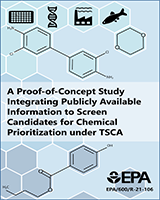NCBI Bookshelf. A service of the National Library of Medicine, National Institutes of Health.
A Proof-of-Concept Case Study Integrating Publicly Available Information to Screen Candidates for Chemical Prioritization under TSCA [Internet]. Washington (DC): U.S. Environmental Protection Agency; 2021 Jun.

A Proof-of-Concept Case Study Integrating Publicly Available Information to Screen Candidates for Chemical Prioritization under TSCA [Internet].
Show detailsRegulatory agencies worldwide need to make decisions on chemical substances4 based on a set of defined criteria on specific hazards of concern, exposure to specific populations, or persistence and bioaccumulation in the environment. There is a need for a consistent, timely and efficient approach to organize large numbers of chemical substances for further evaluation. This document describes an approach to integrate publicly available information on the more than 33,000 chemical substances on the non-confidential TSCA active inventory5 to efficiently select chemical substances for expert review prior to prioritization. The information in this document expands on the long-term strategy previously described by the EPA6, continuing with the development of the PICS approach for synthesizing information from traditional and NAMs in key scientific domains. These domains include human health hazard to exposure ratio (incorporating multiple specific toxicities), ecological hazard, carcinogenicity, genotoxicity, human exposure (general and susceptible populations), persistence/bioaccumulation, skin sensitization, skin irritation, and eye irritation. Of the seven domains used in the PICS approach, five were included in the previous Working Approach for Potential Candidates. The additional two domains (carcinogenicity; skin sensitization and skin/eye irritation) were included in the PICS approach based on their use in the 2014 TSCA Work Plan7. The detailed process was tested in a proof-of-concept case study. The PICS approach may help streamline the evaluation of chemical substances by transparently and reproducibly synthesizing available information and identify potential data gaps, and aspects of the approach could be adapted and applied to other prioritization decision contexts.
This document presents a proof-of-concept approach for EPA and the broader scientific community, and neither constitutes rulemaking by the EPA, nor can it be relied on to create a substantive or procedural right enforceable by any party in litigation with the United States. Non-mandatory language such as “should” provides recommendations and does not impose any legally binding requirements. Similarly, statements about what EPA expects or intends to do reflect general principles to guide EPA’s activities and are not judgments or determinations as to what EPA will do in any particular case.
Footnotes
- 5
This list can be found at https://comptox
.epa.gov /dashboard/chemical_lists /TSCA_ACTIVE_NCTI_0320 - 6
- 7
TSCA Work Plan Methods Document 2012 (https://www
.epa.gov/sites /production/files /2014-03/documents /work_plan_methods_document_web_final .pdf).
- Introduction - A Proof-of-Concept Case Study Integrating Publicly Available Info...Introduction - A Proof-of-Concept Case Study Integrating Publicly Available Information to Screen Candidates for Chemical Prioritization under TSCA
Your browsing activity is empty.
Activity recording is turned off.
See more...